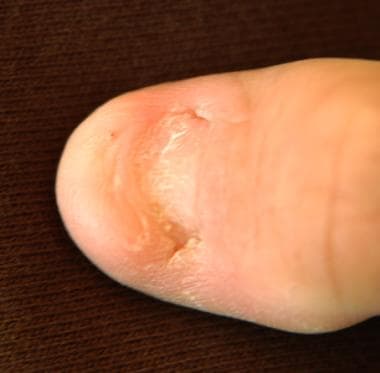Practice Essentials
Nail-patella syndrome (NPS; OMIM 161200) is an autosomal dominant condition characterized by the classical clinical tetrad of nail dysplasia, patellar aplasia-hypoplasia, elbow arthrodysplasia, and iliac horns. The nails may be absent, hypoplastic, or dystrophic with ridges, pits, and/or triangular lunulae. [1] See the image below.
Typically, nail anomalies are symmetrical; the thumbs are most severely affected, and severity decreases progressing toward the fifth digit. The patella may be absent, small, or irregularly shaped. Dislocation in a superior and lateral direction is common if patellae are present. Elbow anomalies may include decreased extension, pronation, supination, and/or pterygia. Patellae and elbow anomalies may be asymmetrical. The iliac horns are bony prominences that project posterolaterally from the iliac bones. Although rarely palpable, they are radiographically visible in most patients with nail-patella syndrome. [2]
Proteinuria with or without hematuria occurs in 30-50% of affected individuals, but progresses to end-stage renal disease in approximately 5% of patients. [3] Ocular hypertension and open-angle glaucoma is more common in younger patients than in the general population. [4] The third documented chromosomal linkage identified in humans was between the nail-patella syndrome locus and the ABO blood group on chromosome 9. [5] LMX1B, located at 9q34.1, is an LIM-homeodomain transcription factor required for the normal development of dorsal limb structures, the glomerular basement membrane, the anterior segment of the eye, and dopaminergic and serotonergic neurons. Heterozygous loss-of-function mutations in LMX1B cause nail-patella syndrome. [6, 7, 8, 9, 10]
Signs and symptoms of nail-patella syndrome
Pes planus is seen in majority of patients with nail-patella syndrome. These patients also tend to have an overall typically thin body habitus, and they have difficulty gaining weight. Other findings on physical examination may include the following:
-
Nail/digit anomalies - Nails may be absent, hypoplastic, or dystrophic; triangular lunulae may be the sole nail anomaly; decreased creases over the distal interphalangeal (DIP) joints are noted
-
Patellar anomalies - Patellae may be absent or hypoplastic; dislocation in the superior and lateral direction is common; pain is also common, and osteoarthritis may be present
-
Iliac horns - These bony prominences are typically asymptomatic and may be palpable on the posterolateral iliac bones
-
Elbow anomalies - Decreased flexion, supination, and pronation are noted; the radius may be hypoplastic and posteriorly placed; skin webbing (pterygia) may be present
-
Renal disease - Proteinuria with or without hematuria may be present in 30-50% of patients; this progresses to end-stage renal disease in approximately 5%
-
Open-angle glaucoma
-
Lester sign - A hyperpigmented, irregular ring in the iris may be noted
Workup in nail-patella syndrome
Laboratory studies
LMX1B sequencing is diagnostic in the majority of patients. [11, 12, 13] LMX1B mutations in exons 2-6 can be found via DNA sequencing in 80-85% of patients with nail-patella syndrome, and an additional 5% can be picked up with deletion and duplication analysis.
Imaging
Radiography may reveal iliac horns, hypoplastic patellae, or abnormal radial heads.
Procedures
These include the following:
-
Renal biopsy - May be indicated after referral to nephrologist for evaluation of progressive renal insufficiency, proteinuria, and hypertension in nail-patella syndrome
-
Light microscopy - Reveals glomerulonephritis and basement membrane thickening; however, negative results do not rule out pathologic processes in the kidney
-
Electron microscopy - Can reveal ultrastructural changes, such as irregularities and thickening of the basement membrane and the presence of collagen-like fibrils within the basement membrane, which cannot be seen with light microscopy
Management of nail-patella syndrome
Angiotensin-converting enzyme (ACE) inhibitors for proteinuria, hypertension, or both are indicated in patients with nail-patella syndrome.
Physical therapy, bracing, and analgesics may be needed for joint pain. Caution is necessary in using analgesics, particularly nonsteroidal anti-inflammatory drugs (NSAIDs), because renal disease may also be part of this condition.
Dialysis and/or renal transplant may be indicated in as many as 5% of patients who have renal involvement that progresses to end-stage renal disease.
Patella realignment surgery may help in cases of recurrent dislocation. Joint replacement may be beneficial in cases of severe osteoarthritis of the knee or elbow.
Excision of the radial head should be undertaken only after careful consideration and only for pain relief, as range of movement is not usually improved significantly by surgery.
Pathophysiology
Although the joint anomalies in nail-patella syndrome may limit range of motion (ROM), the associated glaucoma and nephropathy may be the most serious complication. Asymptomatic proteinuria may persist for years; however, end-stage renal failure occurs in less than 5%.
Mutations in the homeodomain of LMX1B versus LIM-A or LIM-B may be associated with proteinuria. However, further investigation of a larger population of patients with nail-patella syndrome (ideally sporadic) is needed to determine if this genotype-phenotype correlation is valid outside large pedigrees of nail-patella syndrome, which may be simultaneously segregating nephropathy-related genes.
Epidemiology
Frequency
United States
Nail-patella syndrome has been recognized for more than 100 years. It has an estimated prevalence of 1 per 50,000 live births.
International
Nail-patella syndrome has been described in multiple populations.
Mortality/Morbidity
The severity of clinical features and manifestations cannot be predicted. Orthopedic problems may be treated with analgesics, physical therapy, bracing, and/or surgery. With concurrent renal disease, nonsteroidal anti-inflammatory drugs (NSAIDs) must be used cautiously to avoid worsening renal function. If orthopedic surgery is planned, MRI prior to surgery is recommended because joint structures (ie, ligament, tendon and muscle insertions, vessel locations) are typically distorted in patients with nail-patella syndrome.
Renal disease that manifests as proteinuria with or without hematuria occurs in 30-50% of patients, but progression to end-stage renal disease occurs in less than 5%. Hypertension and renal disease are treated as in the general population, with recognition that ACE inhibitors have been shown to slow progression of proteinuria in nail-patella syndrome. Patients who have undergone renal transplantation usually have good results. Glaucoma should also be treated as in the general population, but with increased surveillance in all patients with nail-patella syndrome (eg, annual ophthalmologic examination with glaucoma screening).
Race
No race predilection has been reported.
Sex
Males and females are equally affected.
Age
Prenatal diagnosis based on ultrasonography detection of iliac horns is reported; talipes may also be detected on antenatal ultrasonography. Nail anomalies and contractures of the knees or elbows may be noted at birth. Abnormal patellae are often noted in early childhood. Renal disease may occur at any age. When present, the onset of glaucoma or ocular hypertension is usually in adulthood but at an earlier age than in the general population. Other disease manifestations span all ages.
-
Nail of a patient the nail-patella syndrome.
-
Decreased severity of nail dystrophy towards the fifth finger and loss of skin creases over the distal interphalangeal joints. Courtesy of Journal of Medical Genetics, BMJ Publishing Group Ltd.
-
Triangular lunules. Courtesy of Journal of Medical Genetics, BMJ Publishing Group Ltd.
-
X-ray of pelvis showing iliac horns. Courtesy of Journal of Medical Genetics, BMJ Publishing Group Ltd.
-
X-ray of pelvis showing iliac horns in early childhood. Courtesy of Journal of Medical Genetics, BMJ Publishing Group Ltd.
-
Lester's sign of the iris. Courtesy of Journal of Medical Genetics, BMJ Publishing Group Ltd.











